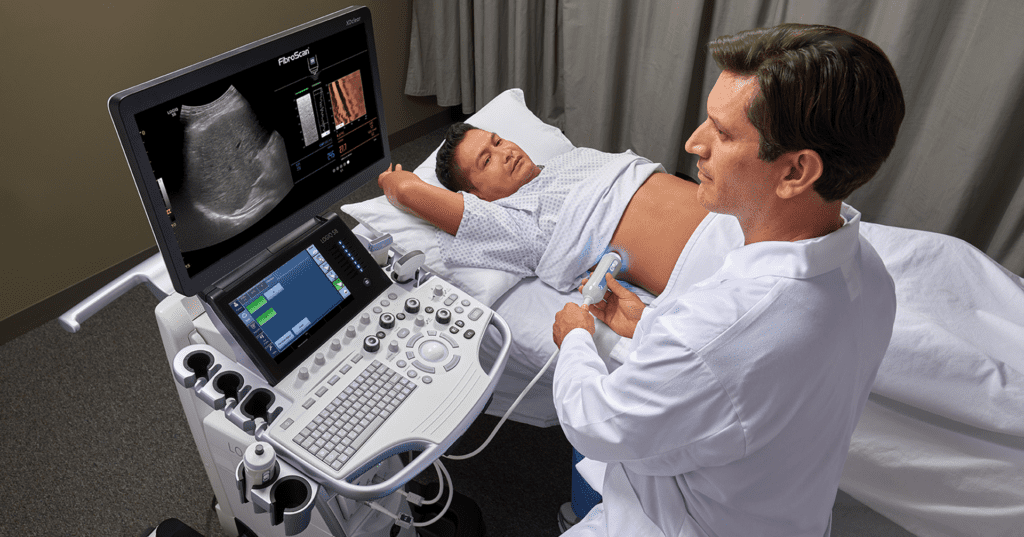 The liver is the second largest organ in the body, and it performs many jobs. It processes what you eat and drink into energy and nutrients your body can use. It also removes harmful substances from your blood. FibroScan is a specialized machine for your liver. It measures fibrosis (scarring) and steatosis (fatty change) in your liver. Fatty change is when fat builds up in your liver cells. Non-alcoholic fatty liver disease (NAFLD) is the buildup of extra fat in liver cells that is not caused by alcohol. An estimated 100 million Americans, 25%, have NAFLD. It is normal for the liver to contain some fat, however, when fat makes up more than 10% of the liver’s weight it is considered a fatty liver (steatosis). In its mildest form, the disease does not cause much trouble and presents with few (if any) symptoms and/or complications. However, if NAFLD is left unaddressed it can develop int a much more harmful disease-state called non-alcoholic steatohepatitis (NASH), which involves inflammation of the liver. NASH affects 20% of those with NAFLD. It occurs when scar tissue (fibrosis) is visible in the liver. Fibrosis can develop into advanced scarring (cirrhosis) or liver cancer.
The liver is the second largest organ in the body, and it performs many jobs. It processes what you eat and drink into energy and nutrients your body can use. It also removes harmful substances from your blood. FibroScan is a specialized machine for your liver. It measures fibrosis (scarring) and steatosis (fatty change) in your liver. Fatty change is when fat builds up in your liver cells. Non-alcoholic fatty liver disease (NAFLD) is the buildup of extra fat in liver cells that is not caused by alcohol. An estimated 100 million Americans, 25%, have NAFLD. It is normal for the liver to contain some fat, however, when fat makes up more than 10% of the liver’s weight it is considered a fatty liver (steatosis). In its mildest form, the disease does not cause much trouble and presents with few (if any) symptoms and/or complications. However, if NAFLD is left unaddressed it can develop int a much more harmful disease-state called non-alcoholic steatohepatitis (NASH), which involves inflammation of the liver. NASH affects 20% of those with NAFLD. It occurs when scar tissue (fibrosis) is visible in the liver. Fibrosis can develop into advanced scarring (cirrhosis) or liver cancer.
FibroScan is an easy, non-invasive test to detect fatty liver. With FibroScan, NAFLD can be detected early and may be successfully treated with lifestyle changes. Your progress can also be monitored with FibroScan as it provides a CAP score. A CAP score is a measurement of fatty change in your liver and is used to determine steatosis grade. Talk with your physician about your NAFLD risk and if you could benefit from a FibroScan test.
People who are overweight or obese, have diabetes, high cholesterol or high triglycerides are at risk of developing NAFLD. Certain medications and poor eating habits may also lead to NAFLD.
- It is recommended that you wear comfortable, loose-fitting clothing.
- Nothing to eat or drink 6 hours prior to test.
- Do not smoke or use any tobacco products for at least 2 hours prior to appointment.
You will be positioned lying face-up on a padded examination table which can be tilted or moved. A clear water-based warm gel is applied to the area of the body being studied to help the transducer make secure contact with the body and eliminate air pockets between the transducer and the skin. The sonographer (Ultrasound Technologist) then presses the transducer against the skin and sweeps it over the area of interest. The Sonographer is able to review the ultrasound images in real-time as they are acquired. The FibroScan examination should take under 30 minutes.
